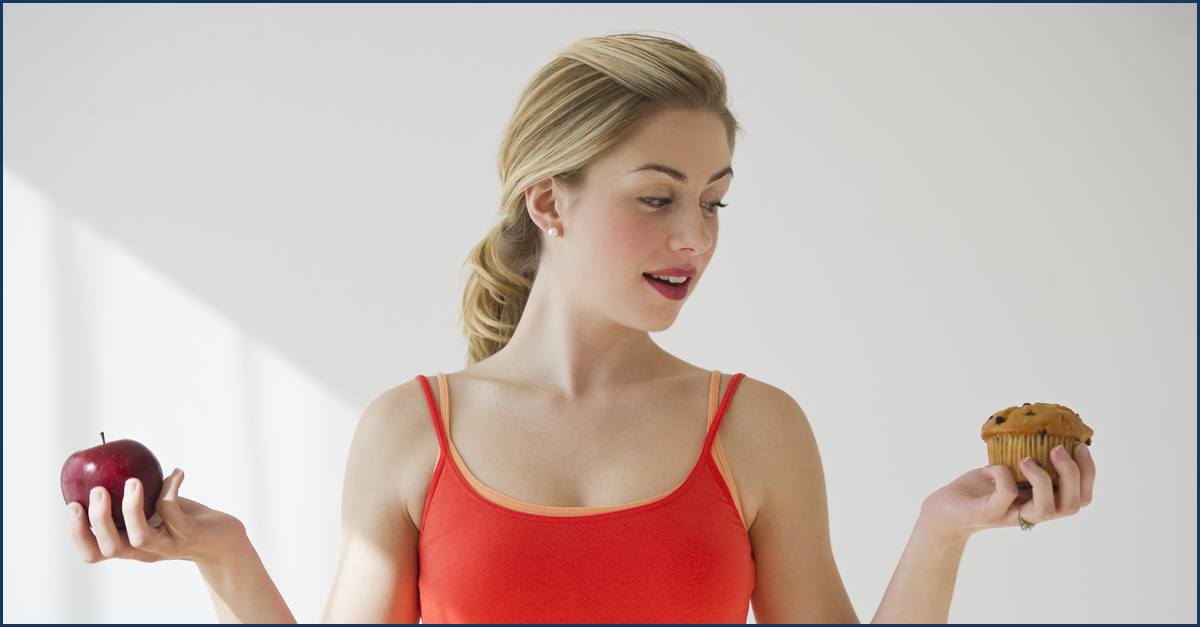I hear this all the time when working with new nutrition clients:
"I can't lose weight because I eat too much"
It seems that people blame their troubles with weight control or weight loss on the fact that they have a hard time controlling what they eat.
But, is this really the case?
When I look deeper into this complaint, it's not really the issue at all.
Most often people fail to actually eat ENOUGH at all their meals:
- They skip breakfast
- Try to eat barely anything at lunch
and then are so hungry when they get home at night they either eat continuously, or snack without thinking while watching the late night news.
When they do this, they end up making poor food choices because there was no planning put into what they should eat, or, can't say No to tempting, low-nutrition foods (ice cream, crackers) because they are so hungry.
Then, the next morning, they are still full (or feel guilty) from all the late-night snacking the previous night, that they try to barely eat anything all until later in the day. This is bad though because it sets the body up to store everything it finally does get to eat and makes weight loss even harder.
Not good at all.
Bottom line: Regular eating patterns, whether it be three square meals a day, or meals eaten every 3 to 5 hours, are much better for appetite and calorie control than trying to starve yourself, which likely leads to binging later.
Keep your calories in check by having a plan each day for your meals and make sure they are spaced evenly apart versus eating whatever, whenever.
Keep this mantra in mind: "If you fail to plan, you plan to fail"; for weight loss and appetite control, this couldn't be any more accurate.
But, What If You Truly Eat Too Much? Even With Regularly Spaced Meals and Snacks?
Yes, there are some people that truly have a hard time eating less and often eat more than their body needs, even if they have a plan. No matter how careful they are with their meals, their total food intake usually ends up being more than what they need.
Either they fill their plate too full, or come back for seconds, even though they don't need it.
So, why is this? Why do some people not seem to have an 'off' switch? What is it about them, or the situation that makes it so hard to eat less and stop before they're stuffed?
Some people don't have an OFF switch
Let's look at some of these factors so you can understand what drives your desires for food. And maybe the next time you're faced with more food than you need, you'll be able to push away from the table and not think about it anymore.
1. The Bigger the Plate, the More You Eat
Just like houses, plate sizes have gotten bigger and bigger over the years. In fact, most portion sizes of foods are bigger than what we really need.
No longer is a 9- or 10-inch dinner plate good enough (that size is for salads). Now, most dinner plates span 11 to 12 inches across, while cup and bowl sizes have also increased.
These larger sizes encourage people to add more food, and subsequently eat more than they really need, leaving themselves feeling over-full and guilty.
Researchers from Cornell University showed that people consume 22% more food when it was served on a larger plate or bowl, than a smaller one, adding to an already increasing waistline.
A bigger plate will encourage you to eat more.
Even nutrition experts are unable to resist: when nutrition professors served themselves ice cream into a big bowl they gave themselves 31% more than those given a smaller bowl. Then, if they were given a large spoon, their scoop portion increased by 14%. So, regardless of education, even the wise can be fooled into eating more.
Bottom Line: Choose dinnerware that your grandparents would eat off of (small and practical), especially if you can't hold back during a good meal.
2. The Prettier the Plate, the More You Want to Eat
Scientists tested the attractiveness of a serving dish and how it influenced a person's perception of the food they were eating.
People were served a brownie on a napkin, a paper plate, or a nice china dish and then asked what they thought.
After eating it off the napkin, they thought the brownie was alright. After the paper plate, it was pretty good. But after eating off the china, it was really, really good and the greatest brownie they'd ever eaten. They chose to pay more for the brownie when it was served on good china and wanted to eat more.
Got nice dishes? You'll eat more food
Take Home Message: If you want people to eat more, give them exceptional dinnerware to eat off of, but if you're trying to encourage yourself to eat less, choose plates that are slightly boring.
3. If You Can See It, You'll Probably Eat It
Visual cues are one of the strongest predictors of overeating, or eating when not necessary.
That's why television commercials at night often show images of tantalizing snack foods or creamy sugary treats. Not only are you tired and looking for a boost from a long day, but when your mind sees it, it thinks about how good it would taste. Eventually you'll run to the pantry to seek out your own evening snack.
The same thing goes for parties; when food is out in plain sight, people are more likely to eat it, whether they're hungry or not. But, if that food was covered and invisible to the eye, it wouldn't get wolfed down.
Weight Loss Tip: Keep sweet treats and tempting food in an opaque container, or completely out of sight so thoughts of sugar won't dance through your head. Or, better yet, don't keep them in your house at all.
4. Close Food = Eaten Food
Picture this: you're sitting in front of your computer working away, but you have a bag of pistachios also sitting beside you on your desk.
You know you're not really that hungry, but because those tasty green pieces of goodness are within arm's reach, you're more likely to eat them than if you have to go into the kitchen to seek them out.
And so you do, and before you know it, the bag is almost empty and the pile of shells starts falling onto the floor. You feel stuffed and embarrassed, but you can't go back in time in change it.
If food is within arm's reach, you're more likely to eat it
If you have more time to think about what you're about to eat, by forcing yourself to travel to get it, you're more likely to rethink your unnecessary cravings.
Bottom Line: If ice cream is your passion, don't even keep it in the freezer where you're likely to grab it right after eating dinner. You'll think twice if you have to drive somewhere to chow it down and will probably just say no.
5. Avoid Dining with a Big Eater
You're going out to dinner with your pro-swimmer friend Kathy, but you know good and well that she eats a lot more than you because her metabolism is cranking on overtime from all her exercise training.
So, you try to eat less than her, but for some reason you still end up chowing down more than you need.
Why is this? Scientists from Cornell also discovered that people mimic how their dining partners eat. When you're seated in front of a person eating a large meal, you're more likely to eat a larger meal than normal and over-doing your intake.
Or, if that person with you eats fast, you may also find yourself eating faster than you'd usually eat, and in turn, taking in more calories.
Weight Loss Tip: If you're eating a meal with a big or fast eater, ensure your portion size is fixed to be smaller on purpose. And, make sure you don't share dessert with her, no matter how good it looks.
Overall, you CAN control your food portions with enough practice and discipline. Keep your goals in mind before you reach for more food than you need.
At the end of the day, a lot of people (fitness trainers included!) forget that being healthy and fit requires a lifestyle mindset - you cannot rely on shortcuts for anything sustainable. And it's that same approach that I try to teach to my students (as a professor) and my clients (as a trainer) - that you need to empower yourself completely instead of just focusing on one little thing (for example, the number on your scale).
With regards to training, I collaborated with Lou Schuler and Alwyn Cosgrove to write, The New Rules of Lifting for Women, where our tagline was "Lift Like a Man, Look Like a Goddess" . However, some people took that out of context and didn't understand that there are serious considerations for training women, specifically those who have never been exposed to strength training before.
Some things to consider:
- Valgus collapse and an increased Q- angle based (distance from hip to knee) relative to men. This can manifest itself in issues with the knees. To address this, women in general should have more exercises in their programming to strengthen the muscles around the knee, specifically the VMO.
- Weaker posterior chain. Most untrained women are quad dominant, and have a weak pelvic floor either from childbirth or years of holding their pee, which caused weakness. You see this most during a squat pattern (notice how most women naturally bend at the knee rather than the hip). To correct this women need to focus more on glute, core and the entire posterior chain, compared to men.
- Hyper mobility at the biceps and hamstrings, and for some women, total body. Yes, being able to stretch like a Cirque de Soleil athlete may look pretty cool, but this instability leads to more injury. Stability is a focus of programs for women.
- Women are are more able to handle higher volumes than men and less rest between sets and exercises. If you give a woman a man's program, she'll be bored and under-stimulated...
Overall, there are a lot of considerations for training women that most programs fail to address.
xxx
References
1. Physiol Behav. 2010 Jul 14;100(5):454-63. Epub 2010 May 12. From mindless eating to mindlessly eating better. Wansink B.
2. Am J Prev Med. 2006 Sep;31(3):240-3. Ice cream illusions bowls, spoons, and self-served portion sizes. Wansink B, van Ittersum K, Painter JE.










